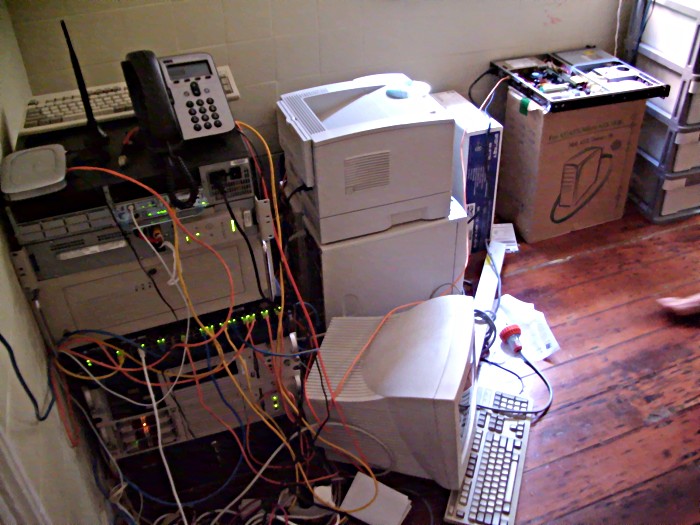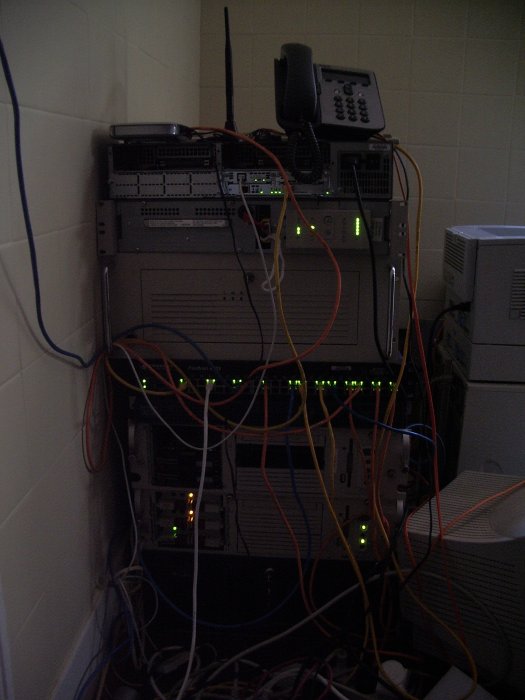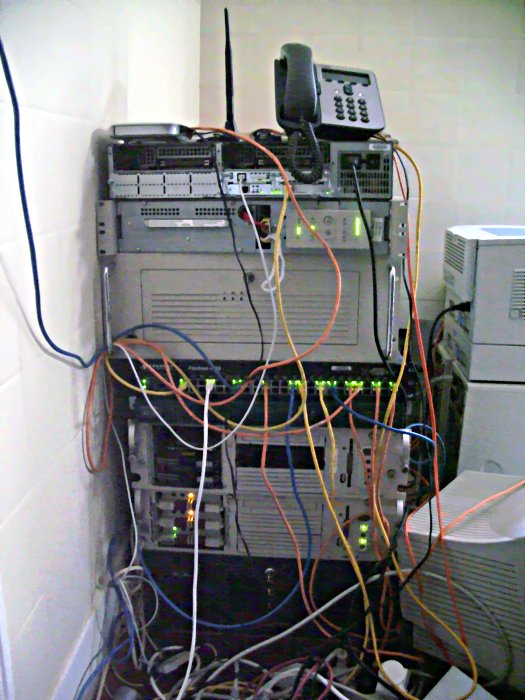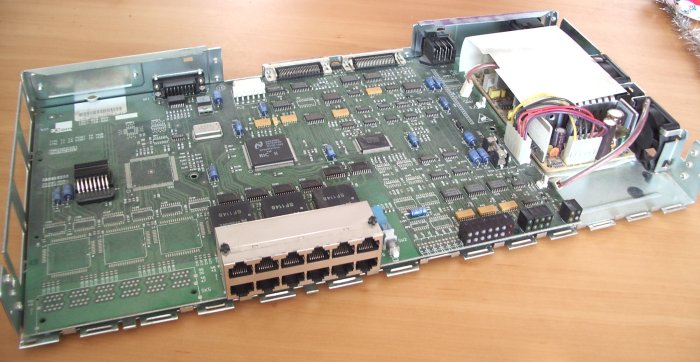01 Jan 2006
Good fun. They’ve only been in the house (which doesn’t have a domain yet! I suggest TEDonMarian.net) for two weeks, but already have… err… the most important stuff sorted.

The rack, I’m assured, is coming. ;-)
Oh, no, there is a domain. http://lttd.net/ is it.
01 Jan 2006


I ♥ the GIMP.
The above edit (dark is before, light — visible — is after) took me about a minute and a half, and went something like Curve, Despeckle, Resample (scale for web), Despeckle (finer adjustment on wand-selected area), Unsharp Mask. I don’t think I even know how to do all those things on Photoshop!
But that wasn’t the purpose of this post. The darker original was the source from which I extracted the quite-visible lighter version. That is why I nearly always shoot with my flash off: it’s possible to recover ridiculous amounts from the shadows — even with a crappy digital that won’t let you use RAW — but it’s nigh on impossible to recover that lost to the nether-regions of over-exposed stock.
31 Dec 2005
Yeah. Oh yeah. Everything else works fine, but the brand-name power supply (AOpen) had to keel over and die. Admittedly, it was only a 235W in a system with two optical drives, two hard drives, and a 1.8GHz processor with 768MB of RAM (I just kept adding things to it without really thinking about power til yesterday, when the type of crash/hang I kept getting struck me as being a classic power problem), but… a web-cam?!
That’s ridiculous. But true.
Anyway, I’m planning on violating (yet again — serial offender, here) the “No user-serviceable parts” sticker on the now-dead power supply so I can fix it to use it in another system. I swapped it out for some generic Happy Star Lucky Fortune Power thing (yeah, the name is parodic… it mightn’t have to be, though!) I had lying around — only 250 watts, mind — and everything turned back on again.
Well, kinda. The web-cam still doesn’t work on this machine, but I’m inclined to think that’s Linux (kernel-level/modprobe crap) being screwy, and not hardware particularly. Might be power again, but I doubt it.
And the web-cam is fine. I tested it on a Windows box and was delighted with the rather-un-crappy quality of it. Which you’d kinda expect seeing as it does 1.3MP still images, but I digress. Fixed-focus, but the exposure auto-balance is pretty decent, so I’m happy. Good exposure capabilities are what make crappy cameras less crappy.
As for the hub-that-wasn’t-a-switch, well… it’s going back this afternoon, if the place is open. They open IT-shop-like hours (i.e. open late, close later :P), so I’ll head down after midday. Hopefully I can just get a refund on the 3Com hub, because I don’t really need a new switch after all (though I want one that’s more solid + doesn’t make squealing noises incessantly!).
Oh, yeah, pictures. Here’s the 3Com hub on the inside. Because I had to unplug the fans, which were grinding annoyingly (barely spinning), and because I make it a habit to open up any bit of second hand gear to check for… dust, insects, anthrax. Whatever. The real reason is geekery.

Note howit’s designed to readily accommodate 24 ports. The 6 port model, reputedly, also has the same design, though presumably you’d need different types of chips there (divide 12 by three then try and multiply by a whole number to get 6… you can’t). Anyway, it’s after 12… I’m off!
30 Dec 2005
On the cake that wasn’t. Well, it looked like itcould be a cake, but was actually an oversized muffin. Like the second 10Mbit hub I now own.
Anyway, this oversized-muffin isn’t even resolving the connectivity problems I was having. I have determined with some degree of certainty that the cause of rollercoaster-like Internet access lies exclusively with that D-Link piece of crap/excuse of a router. Which I have only once mentioned in the past here. Suffice to say it was bought chiefly because of my lack of time to get a proxy/PC-based router setup at the beginning of this year, and I didn’t like the idea at the time (‘usurped’ was the word I used, I believe), and like it even less now.
The first Battle of the Firmware has been fought, but, as with the Battle of the Cowshed (I just read Orwell’s Animal Farm), it ultimately just resulted in a change in title of those who were in power: the nature remains the same. Okay, enough trying to apply Communist theory to routers. Basically the firmware I settled on works fine until you actually start trying to use the wireless part of the router. Don’t buy D-Link.
Proposed solutions to the day’s problems:
- Take the 12pt back with some grunting and moaning.
- Use the shiny new Samba server as a caching proxy/Adblock proxy and router
- Revert D-Link piece of crap to the firmware in which wireless works fine, but Bigpond login client does not. Proceed to use as a run-of-the-mill 802.11a/b/g/whatever-the-heck-it-does Access Point.
- Check out the power supply in my Ubuntu desktop (it doesn’t have a cool name… it’s just “josh” on the network, and it wouldn’t do to say “check out the power supply in josh”. The new server, incidentally, is called Whisper.), because it’s possible plugging in a webcam was the straw that broke the camel’s back. Unlikely, but possible. If not, it’s going to be the motherboard. In which case I’ll probably cry for a while, then realise that the motherboard didn’t have Firewire, its onboard audio broke very early on, and that I could do with some more USB ports anyway. No, processor speed doesn’t come into the equation at all… though I’ll readily admit I’d be happy to have something faster. Oh, yeah… all this means I need to spend more money on a new motherboard and processor :(
Well, unless it’s just the power supply. In which case I can get away without buying any new toys. Thank goodness.
And whenever I finally get around to moving to Team Mac — though I’m not too keen on the Mini anymore, having got one at work and realising:
- They have an external power supply that is bloody enormous. Of course, being Apple-made, it’s a damn sexy power supply, but that doesn’t negate the fact it’s roughly the size of a house-brick.
- It’s impossible to have dual monitors, due to the lack-of-space-for-anything.
– But *when *I finally move to Team Mac, I’m looking forward to putting that system out to pasture in a working state. And never again will it have anything weird and wonderful plugged into it. It can just sit, and contemplate what on earth was going on when that strange bulbous thing with a USB lead was plugged into it.
30 Dec 2005
I thought I’d clinched a really good bargain. Being one of those people who see buying stuff as potentially being really good, that is, and not simply a loss of money. The guy at the computer shop–being the only one open within walking distance at this time of year, and myself not sufficiently motivated to travel to the city to buy things from people I hate–was particularly charming, in an Asian-computer-store-owner-with-whom-it-is-generally-difficult-to-communicate kind of way. He assumed I knew everything, which is a nice thing to get in computer stores (for me)… but thank God I wasn’t trying to buy anything more serious than a switch, or else I’d have been sorely regretting having stopped trying to keep up with processor/motherboard developments 18 months or so ago. As it stands, I am now regretting that… but we’ll come to that soon enough.
Anyway, I was adamant the switch I bought would be sufficiently devoid of extraneous power packs (external transformers, if we want to be like that), because of the awful mess that exists Where the Wild Things Are… err… I mean, that crevasse into which a wireless access point dangled some months ago. This created complications. Fortunately, the computer-store-owner-person deferred to the top of a microwave, upon which two moderately serious-looking (but vaguely dusty) pieces of networking equipment were perched. He brought one down to within sneezing range.
Glance: 3Com. Dusty.
First question: is it 10/100? It was an ostensibly intimidating device, vaguely reminiscent of my (10Mbps) Baystack enterprise-level gadget. We both assumed it was 16 ports at the time, though on later inspection (i.e. more than a cursory glance sufficient to fulfil the essential requirements of brand and ancillary textual information on the device’s front-plane, of which there was sparsely little) I discovered it was, in fact, a 12 port. As is the Baystack.
The speed, he assured me in enthusiastic tones, must be 10/100. “Are you kidding?” and then “Do you know how much these things cost?” I tried to tell him I’d bought a similar device (the 10Mbit Baystack) for $10 a few years ago, but he was in too much of a hurry. At any rate, I think the humour would have been wasted. His asking price was a mere $30. I could deal with that, for a rack-mount thing. What I really wanted was a smaller-than-rackmount switch with an internal PSU in a well-built metal casing, but for double the ports (so I thought, not realising there were only 12 — an 8 port switch was $30 also) and an internal PSU, it was sufficiently attractive. Bargain.
Having saved money on that (I was going to spend up to about $70 if there was a nice enough metal-enclosed switch), I was happy to spend a little more on the other thing I’d made the trip for, and ended up buying something nearly as good as the 16 port 10/100 switch that turned out to be a 12 port 10BaseT switch.
This second purchas is, largely, the fault of open-source software. aMSN had just released version 0.95, which incorporated MSN webcam support… on Linux. This was too cool to be true, and I had to see it in action! Logitech cameras seem to be the only ones with any kind of decent support on Linux (via V4L, if that means anything to anyone out there… do any regular-ish Linux users actually read this blog?), so it had to be one of them. They have a bottom-of-the-line version for about $40 or so, but I’d just saved money. So I spent $70 on the webcam instead.
Which subsequently blew up my computer.


